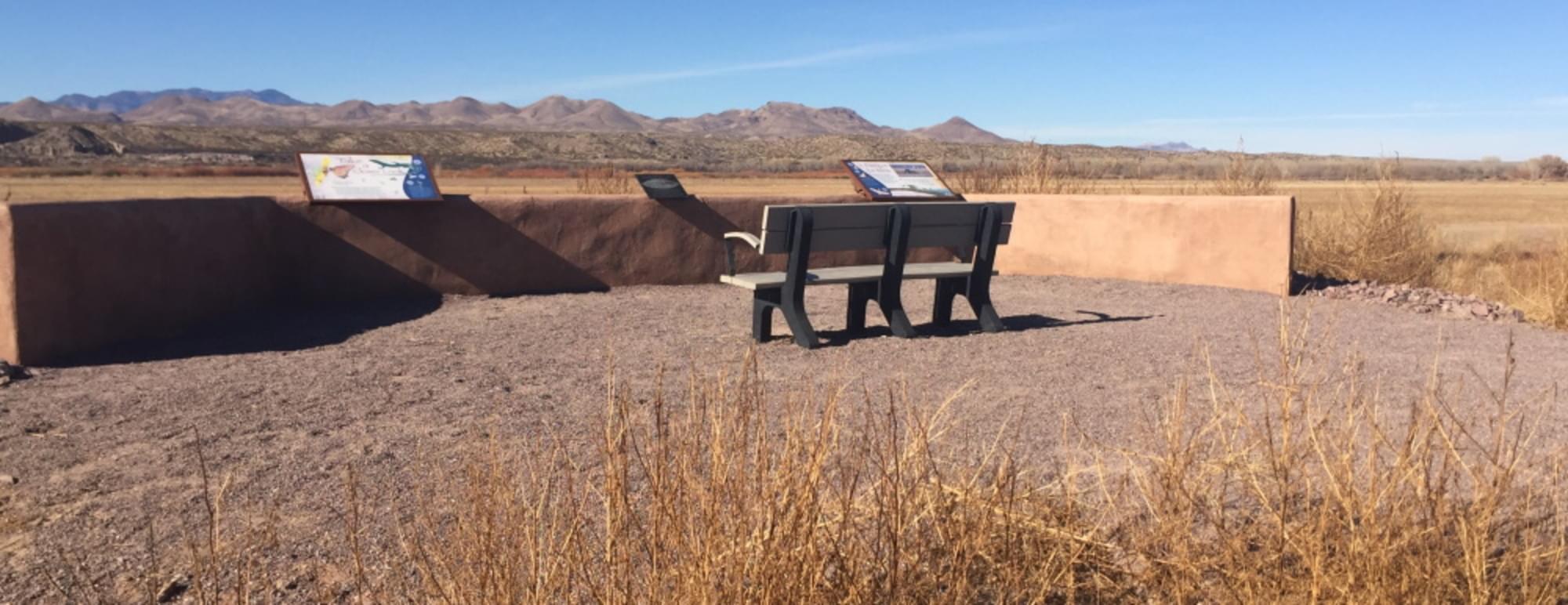Bosque del Apache NWR--John P. Taylor Trail

Bosque del Apache NWR--John P. Taylor Trail
San Antonio, New Mexico 87832
Bosque del Apache National Wildlife Refuge websiteFriends of Bosque del Apache NWR website
Bosque del Apache NWR Important Bird Area (Audubon) website
Habitat! Guide to Bosque del Apache NWR booklet
Bosque del Apache National Wildlife Refuge map
Tips for Birding
The Taylor Trail is accessed from the South Loop, which widens on the right into a trailhead parking area at the end of the Loop’s eastbound portion, about 3 miles from the crossroads after the fee station. The finely-graveled half-mile-long trail is flat and wheelchair traversable. Numerous benches, as well as interpretive signage, are found along the trail and its short offshoots, with a picnic table located on one of these tributaries.
Initially, the trail heads south, with grassland to the east and cottonwoods to the west. Soon the trail winds west, bordered on both sides by giant sacaton and desert broom, but with mature cottonwoods never far away. The trail ends at a viewing area overlooking an agricultural field which may be fallow or planted (say, with triticale); even if fallow, discing, or mowing often attracts birds and other wildlife, as does field flooding.
During fall and winter, this field at the end of the trail is often visited by Snow Goose, Canada Goose, and Sandhill Crane. At this time of the year, look for Western Meadowlark on either side of the trail as you approach the trail end. Other parts of the trail commonly offer fall/winter sightings of Northern Harrier, Red-tailed Hawk, Northern Flicker, American Kestrel, Common Raven, Dark-eyed Junco, and White-crowned Sparrow, with these species sometimes extending their stay into early spring. As water is drained for wading birds in late winter and early spring, if the field at the end of the trail is wet, White-faced Ibis may be present. Early spring is the best time to see Wild Turkey (the Rio Grande subspecies) along the trail, though they have been spotted here in early winter as well. Additional spring visitors include Horned Lark, Mountain Bluebird, Black-throated Gray Warbler, Lucy’s Warbler, and Yellow Warbler. Warblers may continue to be present into early summer, along with Yellow-breasted Chat, Blue Grosbeak, Ash-throated Flycatcher, and Lark Sparrow.
About this Location
The John P. Taylor Jr. Memorial Trail is open daily from one hour before sunrise until one hour after sunset. The trail is a 1-mile roundtrip (level of difficulty: easy).
Explore a restored section of cottonwood savannah and salt grass meadow along a historic channel of the Rio Grande. the habitat is a Cottonwood forest surrounded by salt grass savannah.
Seasonally, search for Wild Turkey, Blue Grosbeak, Great Horned Owl, Northern Flicker, American Kestrel, Common Raven, Desert Side-blotched Lizard, and Botta’s Pocket Gopher.
The trailhead and parking lot are located along the South Loop.
About Bosque del Apache National Wildlife Refuge
See all hotspots at Bosque del Apache National Wildlife Refuge
Established in 1939 to provide a critical stopover for migrating waterfowl, the refuge is well known for the thousands of sandhill cranes, geese, and other waterfowl that winter here each year.
Situated between the Chupadera Mountains to the west and the San Pascual Mountains to the east, the 57,331-acre refuge harbors a wild stretch of the Rio Grande, a ribbon of cottonwood and willow trees visible on the landscape from distant mesas.
Petroglyphs tell the story of ancient people who lived and hunted here. The river and its diversity of wildlife have drawn humans to this area for at least 11,000 years when humans migrated along this corridor, sometimes settling to hunt, fish, and farm. Artifacts and stone tools found nearby tell us that nomadic Paleo-Indian hunters pursued herds of mammoth and bison in the valley.
Today, Bosque del Apache is part of the National Wildlife Refuge System, a national network of lands and waters set aside and managed for the benefit of wildlife, habitat, and you.
Notable Trails
The AllTrails website has a description and map of a hike on the John P. Taylor Trail.
Features
Entrance fee
Restrooms on site
Content from Bosque del Apache National Wildlife Refuge website, Birding in New Mexico (National Audubon Society), and John Montgomery
Last updated March 10, 2024
